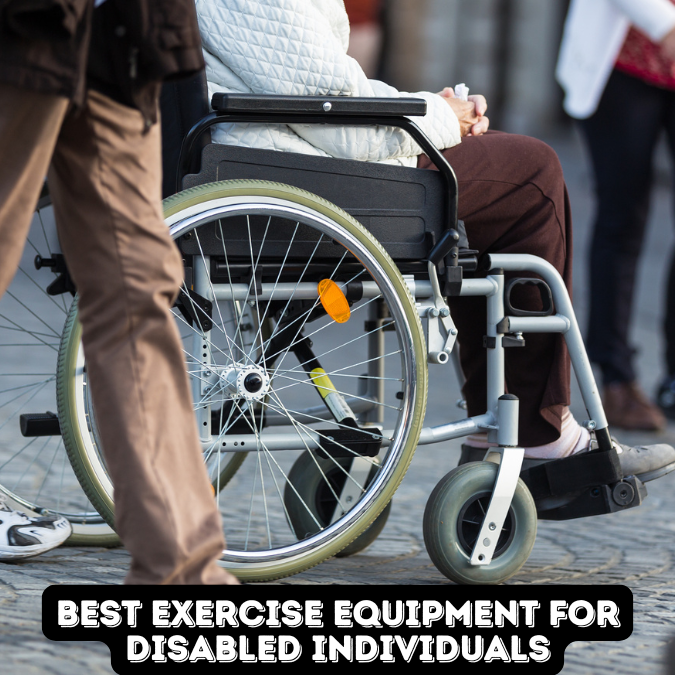
Top 5 Best Exercise Equipment for Disabled Individuals
Best Exercise Equipment for Disabled-Exercise plays a crucial role in maintaining physical health, managing weight, and improving mental well-being, regardless of physical ability. For individuals with disabilities, finding the right exercise equipment is essential to ensure safety, comfort, and effectiveness. This comprehensive guide will explore the best exercise equipment tailored for disabled individuals, providing insights into various types of equipment, their benefits, and tips for selecting the right options.
Types of Exercise Equipment for Disabled Individuals
1. Adaptive Fitness Machines
Adaptive fitness machines are specially designed to accommodate various physical limitations and provide a full-body workout. These machines often feature adjustable components and support systems to cater to different needs.
- Example: Handcycles: Handcycles are a type of adaptive bicycle that is powered by hand cranks. They allow individuals with lower limb disabilities to engage in cardiovascular exercise and build upper body strength.
- Example: Recumbent Tricycles: These provide a stable and comfortable riding experience, suitable for individuals with balance issues or those who require additional back support.
Benefits: Adaptive fitness machines help improve cardiovascular health, muscle strength, and endurance while offering a comfortable and safe workout environment.
2. Accessible Strength Training Equipment
Strength training is crucial for building muscle and maintaining overall health. Accessible strength training equipment includes modifications to standard machines and specialized devices.
- Example: Adjustable Dumbbells: Adjustable dumbbells can be modified in weight to suit the user’s strength and capabilities. They are versatile and can be used for a variety of upper and lower body exercises.
- Example: Resistance Bands: These bands come in different resistance levels and can be used to perform various strength training exercises. They are lightweight, portable, and can be adapted to different exercise needs.
Benefits: Strength training equipment helps in building muscle, improving joint stability, and enhancing functional independence.
3. Seated Exercise Equipment
Seated exercise equipment allows individuals to work out while seated, which is ideal for those with limited mobility or balance issues.
- Example: Seated Ellipticals: These provide a low-impact cardiovascular workout while seated. They are designed to mimic the motion of traditional ellipticals but with added support.
- Example: Seated Rowing Machines: Rowing machines adapted for seated use allow individuals to engage in a full-body workout without requiring standing or high balance.
Benefits: Seated exercise equipment offers a safe and comfortable workout option, reducing the risk of falls and providing a stable base for exercise.
4. Adaptive Cardio Equipment
Adaptive cardio equipment is designed to provide cardiovascular workouts while accommodating various physical disabilities.
- Example: Arm Ergometers: These devices are similar to stationary bikes but are operated by the arms. They are beneficial for individuals who cannot use their legs but want to engage in cardiovascular exercise.
- Example: Step Machines with Handrails: These machines offer a safe way to perform stepping exercises while holding onto handrails for additional support and balance.
Benefits: Adaptive cardio equipment helps improve heart health, endurance, and overall fitness while addressing individual mobility challenges.
5. Aquatic Exercise Equipment
Aquatic exercise equipment is used in water-based workouts, which are beneficial for individuals with joint pain, arthritis, or limited mobility.
- Example: Water Treadmills: These are designed to provide a walking or running workout in a pool, reducing the impact on joints while providing resistance for increased muscle engagement.
- Example: Aqua Resistance Bands: These bands are used in water to provide resistance training, allowing for a low-impact and effective workout.
Benefits: Aquatic exercise equipment minimizes joint stress, provides resistance training, and allows for a full range of motion in a supportive environment.
Tips for Choosing Exercise Equipment
- Assess Your Needs: Determine the type of exercise you want to perform and any specific physical limitations you have. This will help in selecting the most appropriate equipment.
- Consider Safety Features: Look for equipment with safety features such as sturdy handrails, adjustable settings, and comfortable seating to ensure a safe workout experience.
- Consult with a Professional: Speak with a physical therapist or fitness expert who specializes in adaptive exercise to get recommendations tailored to your needs.
- Try Before You Buy: Whenever possible, test the equipment to ensure it meets your comfort and usability requirements.
- Focus on Comfort and Usability: Choose equipment that is easy to use and comfortable for extended periods to encourage regular exercise.
FAQs
1. What are the benefits of using adaptive fitness machines?
- Adaptive fitness machines are designed to accommodate various physical disabilities, providing a full-body workout that helps improve cardiovascular health, muscle strength, and endurance.
2. Can strength training be done with limited mobility?
- Yes, accessible strength training equipment such as adjustable dumbbells and resistance bands can be used to perform strength training exercises safely and effectively, even with limited mobility.
3. What is the advantage of seated exercise equipment?
- Seated exercise equipment provides a stable and comfortable workout environment for individuals with balance issues or mobility limitations, reducing the risk of falls and injuries.
4. How does aquatic exercise equipment benefit individuals with joint pain?
- Aquatic exercise equipment allows for low-impact workouts in water, reducing stress on the joints while providing resistance for muscle engagement and overall fitness.
5. Should I consult a professional before purchasing exercise equipment?
- Yes, consulting with a physical therapist or fitness expert can help you select the right equipment based on your specific needs and ensure a safe and effective workout routine.
6. Where can I find adaptive exercise equipment?
- Adaptive exercise equipment can be found at specialty fitness stores, online retailers, and through organizations that focus on adaptive sports and fitness.
7. How can I ensure that the exercise equipment is safe to use?
- Look for equipment with safety features such as adjustable settings, sturdy construction, and comfortable support. Additionally, ensure the equipment meets industry safety standards.
Conclusion
Finding the right exercise equipment is essential for maintaining an active and healthy lifestyle, especially for individuals with disabilities. By selecting adaptive fitness machines, accessible strength training equipment, seated exercise devices, adaptive cardio equipment, and aquatic exercise tools, you can tailor your workout routine to your specific needs and capabilities. Prioritizing safety, comfort, and usability will help you stay motivated and engaged in your fitness journey. With the right equipment and guidance, everyone can enjoy the benefits of regular exercise and lead a healthier, more fulfilling life.

Leave a Reply